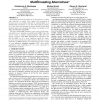Free Online Productivity Tools
i2Speak
i2Symbol
i2OCR
iTex2Img
iWeb2Print
iWeb2Shot
i2Type
iPdf2Split
iPdf2Merge
i2Bopomofo
i2Arabic
i2Style
i2Image
i2PDF
iLatex2Rtf
Sci2ools
ISCA
2002
IEEE
2002
IEEE
Detailed Design and Evaluation of Redundant Multithreading Alternatives
Exponential growth in the number of on-chip transistors, coupled with reductions in voltage levels, makes each generation of microprocessors increasingly vulnerable to transient faults. In a multithreaded environment, we can detect these faults by running two copies of the same program as separate threads, feeding them identical inputs, and comparing their outputs, a technique we call Redundant Multithreading (RMT). This paper studies RMT techniques in the context of both singleand dual-processor simultaneous multithreaded (SMT) single-chip devices. Using a detailed, commercial-grade, SMT processor design we uncover subtle RMT implementation complexities, and find that RMT can be a more significant burden for singleprocessor devices than prior studies indicate. However, a novel application of RMT techniques in a dual-processor device, which we term chip-level redundant threading (CRT), shows higher performance than lockstepping the two cores, especially on multithreaded workloads.
| Added | 15 Jul 2010 |
| Updated | 15 Jul 2010 |
| Type | Conference |
| Year | 2002 |
| Where | ISCA |
| Authors | Shubhendu S. Mukherjee, Michael Kontz, Steven K. Reinhardt |
Comments (0)

